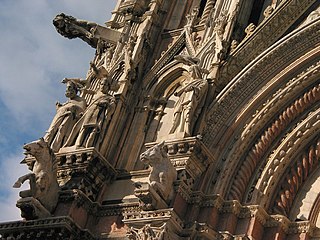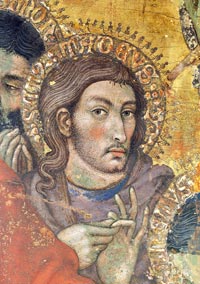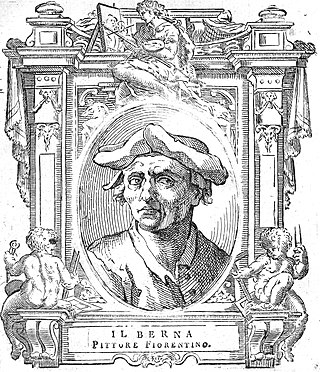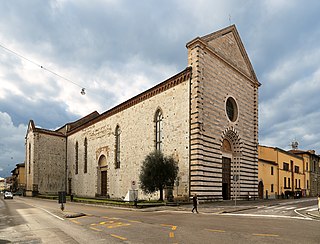
Memmo di Filippuccio (active 1303-1345) was a 14th-century painter from Siena, Italy.

Memmo di Filippuccio (active 1303-1345) was a 14th-century painter from Siena, Italy.
Memmo di Filippuccio is mentioned in the municipal records as painting several works at the Town Hall of San Gimignano in 1303. [1] The frescoed decorations are in the mayoral chamber and show scenes of everyday life. The best known of the frescos are two scenes of domestic bliss. The first shows a husband and wife taking a bath together in a large tub, surrounded by a striped screen and attended by a maid, The second scene shows the bedroom with the maid holding back the curtains to reveal the wife in bed while her husband pulls back the covers to climb in bedside her. [2] These frescos "are among the most frequently reproduced documents used to illustrates daily life.... of the early 14th century." [3] Memmo was given a house and workshop in San Gimignano. [1]
Memmo di Filippucci had two sons who were painters, Lippo Memmi and Federico Memmi. His son-in-law was Simone Martini, one of the most outstanding and influential painters of Siena. In 1317, Lippo di Memmi received a commission to paint a large Maesta in the main chamber of the Town Hall. It is thought that Memmo assisted his son with this work. Memmo may also have worked with Lippo Memmi on the fresco cycle of the New Testament in the Collegiate Church of San Gimignano, completed around 1345. These frescos have long been ascribed to "Barna of Siena" but are now believed to be the work of Lippo di Memmi and workshop. [4]


Domenico di Tommaso Curradi di Doffo Bigordi, professionally known as Domenico Ghirlandaio, was an Italian Renaissance painter born in Florence. Ghirlandaio was part of the so-called "third generation" of the Florentine Renaissance, along with Verrocchio, the Pollaiolo brothers and Sandro Botticelli.

Simone Martini was an Italian painter born in Siena. He was a major figure in the development of early Italian painting and greatly influenced the development of the International Gothic style.

Giovanni Pisano was an Italian sculptor, painter and architect, who worked in the cities of Pisa, Siena and Pistoia. He is best known for his sculpture which shows the influence of both the French Gothic and the Ancient Roman art. Henry Moore, referring to his statues for the facade of Siena Cathedral, called him "the first modern sculptor".

San Gimignano is a small walled medieval hill town in the province of Siena, Tuscany, north-central Italy. Known as the Town of Fine Towers, San Gimignano is famous for its medieval architecture, unique in the preservation of about a dozen of its tower houses, which, with its hilltop setting and encircling walls, form "an unforgettable skyline". Within the walls, the well-preserved buildings include notable examples of both Romanesque and Gothic architecture, with outstanding examples of secular buildings as well as churches. The Palazzo Comunale, the Collegiate Church and Church of Sant' Agostino contain frescos, including cycles dating from the 14th and 15th centuries. The "Historic Centre of San Gimignano" is a UNESCO World Heritage Site. The town also is known for saffron, the dry aged and saffron infused Golden Ham, pecorino cheese and its white wine, Vernaccia di San Gimignano, produced from the ancient variety of Vernaccia grape grown on the sandstone hillsides of the area.

The Collegiata di Santa Maria Assunta or Duomo di San Gimignano is a Roman Catholic collegiate church and minor basilica in San Gimignano, in Tuscany in central Italy. It contains important cycles of Renaissance frescoes by artists including Domenico Ghirlandaio, Benozzo Gozzoli, Taddeo di Bartolo, Lippo Memmi and Bartolo di Fredi. It falls within the UNESCO World Heritage Site of the "Historic Centre of San Gimignano", with its frescoes being described by UNESCO as "works of outstanding beauty".

Benozzo Gozzoli was an Italian Renaissance painter from Florence. A pupil of Fra Angelico, Gozzoli is best known for a series of murals in the Magi Chapel of the Palazzo Medici-Riccardi, depicting festive, vibrant processions with fine attention to detail and a pronounced International Gothic influence. The chapel's fresco cycle reveals a new Renaissance interest in nature with its realistic depiction of landscapes and vivid human portraits. Gozzoli is considered one of the most prolific fresco painters of his generation. While he was mainly active in Tuscany, he also worked in Umbria and Rome.

Taddeo di Bartolo, also known as Taddeo Bartoli, was an Italian painter of the Sienese School during the early Renaissance. His biography appears in the Vite of Giorgio Vasari, who claims that Taddeo was the uncle of Domenico di Bartolo.

Casole d'Elsa [ˈkaːzole] is a comune (municipality) in the Province of Siena in the Italian region Tuscany, located about 50 kilometres (31 mi) southwest of Florence and about 25 kilometres (16 mi) west of Siena.

Bartolo di Fredi, also called Bartolo Battiloro, was an Italian painter, born in Siena, classified as a member of the Sienese School.

Lippo Memmi was an Italian painter from Siena. He was the foremost follower of Simone Martini, who was his brother-in-law.

The Basilica of San Domenico, also known as Basilica Cateriniana, is a basilica church in Siena, Tuscany, Italy, one of the most important in the city. The basilica is an example of Cistercian Gothic style.

Barna da Siena, also known as Berna di Siena, was presumed to be a Sienese painter active from about 1330 to 1350.

Niccolò di Ser Sozzo was an Italian painter and manuscript illuminator. He generally has been identified as Niccolò di Ser Sozzo di Francesco Tegliacci, but recent research points instead to a Niccolò di Ser Sozzo di Stefano. Whatever his true identity, Niccolo was one of the leading panel painters and miniaturists at work in Siena in the mid-14th century. His style is closest to that of Lippo Vanni and his sometime collaborator Luca di Tomme and is ultimately dependent upon the tradition of Simone Martini and, especially, the Lorenzetti brothers, in whose workshop he may have apprenticed.

Pier Francesco Fiorentino was a 15th-century painter active in San Gimignano for much of his mature life, depicting religious-themed subjects.

The Palazzo Comunale, also known as the Palazzo del Popolo of San Gimignano has been the seat of the civic authority in the comune since the 13th century. It is located on the Piazza del Duomo close to the Collegiate Church of the Assumption of the Blessed Virgin Mary. The building and Collegiate Church are at the heart of the medieval town, and are part of the UNESCO World Heritage Site of the "Historic Centre of San Gimignano".

The Saint Fina Chapel is an Early Renaissance chapel in the right aisle of the Collegiate church of Santa Maria Assunta, located in San Gimignano, Tuscany, Italy. It was designed by Giuliano and Benedetto da Maiano in 1468 to enshrine the relics of Saint Fina. The side walls of the chapel are painted in fresco by Domenico Ghirlandaio with two scenes from her life, executed between 1477 and 1478.

Giovanni di Cecco was a Late Gothic architect and sculptor who worked in the region of Siena, Italy, in the 14th century.

Guidoriccio da Fogliano at the Siege of Montemassi is a fresco on the western wall of the Sala del Mappamondo in the Palazzo Pubblico in Siena. It shows Guidoriccio da Fogliano, the commander of the Sienese troops, on horseback against the background of a landscape in which the siege of Montemassi takes place..

San Francesco is a Gothic-style, Roman Catholic church located on the piazza of the same name in Pistoia, region of Tuscany, Italy.
Memmo may refer to: